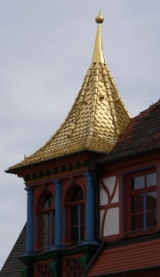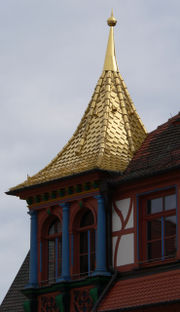
Schwabach
Encyclopedia
Schwabach is a German
town of about 40,000 inhabitants near Nuremberg
, in the center of the region of Franconia
in the North of Bavaria
. The city is an autonomous administrative district (kreisfreie Stadt). Schwabach is also the name of a river which runs through the city prior joining the Rednitz
.
Schwabach is famous for its crafts made of gold
, and particularly gold foil
. In 2004, Schwabach celebrated this tradition with an anniversary festival marking "500 years gold foil in Schwabach".
Around the year 1500 a local typesetter developed the "Schwabacher
" font. This font was used for printing the first bible in German translation, which had been worked out by Martin Luther
.
Schwabach is also the birthplace of composer Adolf von Henselt
, the botanist Johann Gottfried Zinn
, the biologist Ralf Baumeister
and one of the developers of mp3
, Bernhard Grill
. It was often visited by Albrecht Dürer
.
n name Suapaha (later Suabaha, then Villa Suabach) which translates as "Schwaben-Bach" in modern German
, which means "Swabia
n stream
", the first part of the name was given by the Franconians who came to the area about a millenea after the Hallstatt culture
to the people living on the banks of that stream, which were perceived as "Swabia
ns" by them, while the second part of the name is a reference to the stream which flows through town.

Germany
Germany , officially the Federal Republic of Germany , is a federal parliamentary republic in Europe. The country consists of 16 states while the capital and largest city is Berlin. Germany covers an area of 357,021 km2 and has a largely temperate seasonal climate...
town of about 40,000 inhabitants near Nuremberg
Nuremberg
Nuremberg[p] is a city in the German state of Bavaria, in the administrative region of Middle Franconia. Situated on the Pegnitz river and the Rhine–Main–Danube Canal, it is located about north of Munich and is Franconia's largest city. The population is 505,664...
, in the center of the region of Franconia
Franconia
Franconia is a region of Germany comprising the northern parts of the modern state of Bavaria, a small part of southern Thuringia, and a region in northeastern Baden-Württemberg called Tauberfranken...
in the North of Bavaria
Bavaria
Bavaria, formally the Free State of Bavaria is a state of Germany, located in the southeast of Germany. With an area of , it is the largest state by area, forming almost 20% of the total land area of Germany...
. The city is an autonomous administrative district (kreisfreie Stadt). Schwabach is also the name of a river which runs through the city prior joining the Rednitz
Rednitz
The Rednitz is a river in Franconia, Germany, tributary of the Regnitz . The Rednitz is formed by the confluence of the rivers Fränkische Rezat and Schwäbische Rezat, in Georgensgmünd . The Rednitz flows north through Roth bei Nürnberg, Schwabach and the southwestern quarters of Nuremberg...
.
Schwabach is famous for its crafts made of gold
Gold
Gold is a chemical element with the symbol Au and an atomic number of 79. Gold is a dense, soft, shiny, malleable and ductile metal. Pure gold has a bright yellow color and luster traditionally considered attractive, which it maintains without oxidizing in air or water. Chemically, gold is a...
, and particularly gold foil
Metal leaf
Metal leaf, also called composition leaf or schlagmetal, is a thin foil used for decoration. Metal leaf can come in many different shades. Some metal leaf may look like gold leaf but not contain any real gold...
. In 2004, Schwabach celebrated this tradition with an anniversary festival marking "500 years gold foil in Schwabach".
Around the year 1500 a local typesetter developed the "Schwabacher
Schwabacher
The German word Schwabacher refers to a specific blackletter typeface. The term derives from the town of Schwabach.-Characteristics:The small-letter g and the capital-letter H have particularly distinctive forms.-History:...
" font. This font was used for printing the first bible in German translation, which had been worked out by Martin Luther
Martin Luther
Martin Luther was a German priest, professor of theology and iconic figure of the Protestant Reformation. He strongly disputed the claim that freedom from God's punishment for sin could be purchased with money. He confronted indulgence salesman Johann Tetzel with his Ninety-Five Theses in 1517...
.
Schwabach is also the birthplace of composer Adolf von Henselt
Adolf von Henselt
Adolf von Henselt was a German composer and pianist.-Life:Henselt was born at Schwabach, in Bavaria. At the age of three he began to learn the violin, and at five the piano under Frau von Fladt...
, the botanist Johann Gottfried Zinn
Johann Gottfried Zinn
Johann Gottfried Zinn was a German anatomist and botanist member of the Berlin Academy.- Biography :Johann Gottfried Zinn was born in Schwabach....
, the biologist Ralf Baumeister
Ralf Baumeister
Ralf Baumeister is a German professor .He is currently co-director of the School of Life Sciences at Freiburg University's Institute of Advanced Studies....
and one of the developers of mp3
MP3
MPEG-1 or MPEG-2 Audio Layer III, more commonly referred to as MP3, is a patented digital audio encoding format using a form of lossy data compression...
, Bernhard Grill
Bernhard Grill
Bernhard Grill is one of the developers of the MP3 technology.Grill was born in Schwabach and studied Electrical Engineering at the Friedrich-Alexander-University, Erlangen-Nuremberg. From 1988 to 1995 he engaged in the development and implementation of audio coding algorithms at the Fraunhofer...
. It was often visited by Albrecht Dürer
Albrecht Dürer
Albrecht Dürer was a German painter, printmaker, engraver, mathematician, and theorist from Nuremberg. His prints established his reputation across Europe when he was still in his twenties, and he has been conventionally regarded as the greatest artist of the Northern Renaissance ever since...
.
Etymology
The name derives from the old FranconiaFranconia
Franconia is a region of Germany comprising the northern parts of the modern state of Bavaria, a small part of southern Thuringia, and a region in northeastern Baden-Württemberg called Tauberfranken...
n name Suapaha (later Suabaha, then Villa Suabach) which translates as "Schwaben-Bach" in modern German
German language
German is a West Germanic language, related to and classified alongside English and Dutch. With an estimated 90 – 98 million native speakers, German is one of the world's major languages and is the most widely-spoken first language in the European Union....
, which means "Swabia
Swabia
Swabia is a cultural, historic and linguistic region in southwestern Germany.-Geography:Like many cultural regions of Europe, Swabia's borders are not clearly defined...
n stream
Stream
A stream is a body of water with a current, confined within a bed and stream banks. Depending on its locale or certain characteristics, a stream may be referred to as a branch, brook, beck, burn, creek, "crick", gill , kill, lick, rill, river, syke, bayou, rivulet, streamage, wash, run or...
", the first part of the name was given by the Franconians who came to the area about a millenea after the Hallstatt culture
Hallstatt culture
The Hallstatt culture was the predominant Central European culture from the 8th to 6th centuries BC , developing out of the Urnfield culture of the 12th century BC and followed in much of Central Europe by the La Tène culture.By the 6th century BC, the Hallstatt culture extended for some...
to the people living on the banks of that stream, which were perceived as "Swabia
Swabia
Swabia is a cultural, historic and linguistic region in southwestern Germany.-Geography:Like many cultural regions of Europe, Swabia's borders are not clearly defined...
ns" by them, while the second part of the name is a reference to the stream which flows through town.
Timeline

- 750-500: BCECommon EraCommon Era ,abbreviated as CE, is an alternative designation for the calendar era originally introduced by Dionysius Exiguus in the 6th century, traditionally identified with Anno Domini .Dates before the year 1 CE are indicated by the usage of BCE, short for Before the Common Era Common Era...
Archaeological evidence of settlement. - 600-700: Name Schwabach first used to refer to the settlement and the river.
- 1346: City wall built.
- 1371: Municipal law established.
- 1469: Town church built (still in use).
- 1500: (ca.) Schwabacher font invented.
- 1528: City hall built (still in use).
- 1633: First needle factory established in Schwabach.
- 1723: Schwabach river flooded to highest point ever. Markings of the flood are still visible.
- 1768: The landmark Old Linden TreeTiliaTilia is a genus of about 30 species of trees native throughout most of the temperate Northern Hemisphere. The greatest species diversity is found in Asia, and the genus also occurs in Europe and eastern North America, but not western North America...
planted (still there). - 1792: Schwabach became part of PrussiaPrussiaPrussia was a German kingdom and historic state originating out of the Duchy of Prussia and the Margraviate of Brandenburg. For centuries, the House of Hohenzollern ruled Prussia, successfully expanding its size by way of an unusually well-organized and effective army. Prussia shaped the history...
. - 1797: Goethe stayed overnight in Schwabach.
- 1806: Schwabach became part of Bavaria.
- 1849: Railway station built.
- 1941: Schwabach bombed in World War IIWorld War IIWorld War II, or the Second World War , was a global conflict lasting from 1939 to 1945, involving most of the world's nations—including all of the great powers—eventually forming two opposing military alliances: the Allies and the Axis...
- 1945: American military base established in Schwabach.
- 1953: City coat-of-arms introduced.
- 1972: Schwabach became an autonomous administrative district.
- 1975: Partner-city relationship with Les Sables d'Olonne established.
- 1980: Schwabach receives the European Union prize for cultural heritage.
- 1992: US Army to be withdrawn from Schwabach and surrounding areas.
- 2004: 500-year anniversary celebration of the gold foil industry.
Twin towns
 France Les Sables-d'OlonneLes Sables-d'OlonneLes Sables-d'Olonne is a seaside town in western France, by the Atlantic Ocean. It is a commune and a sub-prefecture of the Vendée department.-Events:...
France Les Sables-d'OlonneLes Sables-d'OlonneLes Sables-d'Olonne is a seaside town in western France, by the Atlantic Ocean. It is a commune and a sub-prefecture of the Vendée department.-Events:...
, France Greece Kalambaka, Greece
Greece Kalambaka, Greece

